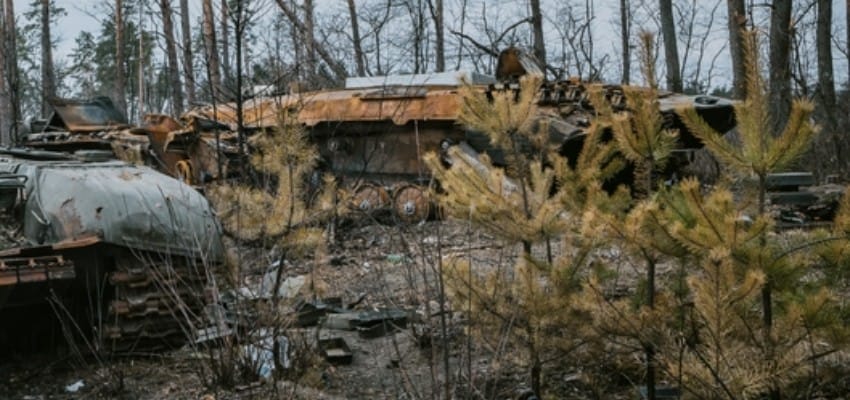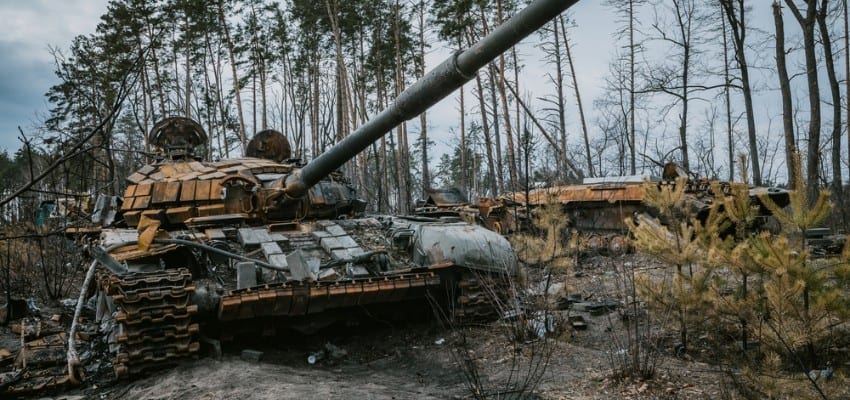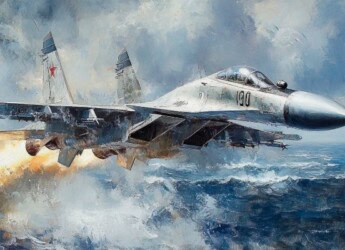|
|
Content Assessment: Incremental Gains? Ukraine Conflict Assessments in Maps (May 29 – June 2, 2022)
Information - 94%
Insight - 93%
Relevance - 92%
Objectivity - 93%
Authority - 95%
93%
Excellent
A short percentage-based assessment of the qualitative benefit of the post highlighting the recent Ukraine conflict assessments in maps from the Institute for the Study of War.
Editor’s Note: One of the most accurate and detailed sources for ongoing updates on the Ukraine crisis is the Ukraine Conflict Update from the Institute for the Study of War. The Institute for the Study of War (ISW) is a 501(c)(3) organization and produces strictly non-partisan, non-ideological, fact-based research. ISW seeks to promote an informed understanding of war and military affairs through comprehensive, independent, and accessible open-source research and analysis. ISW’s research is made available to the general public, military practitioners, policymakers, and media members. Providing a daily synthesis of key events related to the Russian aggression against Ukraine, ISW updates may benefit cybersecurity, information governance, and legal discovery professionals as they follow the business, information technology, and legal trends and trajectories impacted by and stemming from the current Ukraine conflict.
Assessment and Maps*
Ukraine Conflict Assessments – An Overview in Maps
- Institute for the Study of War (ISW), Russia Team
- Critical Threats Project (CTP), American Enterprise Institute
General Assessment Background Info
- ISW systematically publishes Russian campaign assessments that include maps highlighting the assessed control of terrain in Ukraine and main Russian maneuver axes.
- These maps augment daily synthetic products that cover key events related to renewed Russian aggression against Ukraine.
The Russian Offensive Campaign Assessments
- June 2, 2022
- By Karolina Hird, Kateryna Stepanenko, Mason Clark, and George Barros
Russian forces continued to make incremental, grinding, and costly progress in eastern Ukraine on June 2. Russian troops continued operations to capture Severodonetsk and further operations to capture Lysychansk. Russian military leadership will likely use the capture of these two cities to claim they have “liberated” all of Luhansk Oblast before turning to Donetsk Oblast but Russian forces are unlikely to have the forces necessary to take substantial territory in Donetsk Oblast after suffering further losses around Severodonetsk. Russian forces are evidently limited by terrain in the Donbas and will continue to face challenges crossing the Siverskyi Donets River to complete the encirclement of Severodonetsk-Lysychansk and make further advances westward of Lyman towards Slovyansk via Raihorodok.
Russian military leadership continues to experience complications with sufficient force generation and maintaining the morale of mobilized personnel. The Ukrainian General Staff reported that the Donetsk People’s Republic’s (DNR) 1st Army Corps, under Russia’s 8th Combined Arms Army, is conducting forced mobilization in occupied areas of Donetsk Oblast. Russian forced mobilization is highly unlikely to generate meaningful combat power and will exacerbate low morale and poor discipline in Russian and proxy units. The 113th Regiment of the DNR posted a video appeal to Russian President Vladimir Putin on June 2 wherein forcibly-mobilized soldiers complain they have spent the entire war on the frontline in Kherson without food or medicine, and that mobilization committees did not conduct requisite medical screenings and admitted individuals whose medical conditions should have disqualified them from service. Ukraine’s Main Intelligence Directorate additionally released an intercepted phone conversation wherein DNR soldiers similarly complained that physically unfit individuals were forced into service and that mobilized units are experiencing mass drunkenness and general disorder. Russian forces are additionally struggling to successfully rotate servicemen in and out of combat. Spokesperson for the Odesa Military Administration Maksym Marchenko stated that 30 to 40% of Russian personnel that rotated out of Ukraine refused to return, forcing Russian commanders to send unprepared and unmotivated units back into combat. This is consistent with complaints made by DNR servicemen that rotation practices are contributing to poor morale and dissatisfaction within units that have been forcibly mobilized.
Russian occupation authorities continue to face challenges establishing permanent societal control in newly occupied Ukrainian territories. The Ukrainian Resistance Center reported that Russian occupational administrations “are [only] created on paper” and are incapable of controlling local populations, enforcing the use of the Russian ruble, or conducting bureaucratic processes. The Ukrainian Resistance Center noted that Ukrainian civilians welcome partisan activity that systematically sabotages Russian occupation rule.
Key Takeaways
- Russian operations to advance on Slovyansk from the southeast of Izyum and west of Lyman continue to make little progress and are unlikely to do so in the coming days, as Russian forces continue to prioritize Severodonetsk at the expense of other axes of advance.
- Russian forces continued assaults against Severodonetsk and Lysychansk in order to claim full control of Luhansk Oblast.
- Russian forces made incremental advances around Avdiivka.
- Ukrainian counteroffensives in northwestern Kherson Oblast pushed Russian forces to the eastern bank of the Inhulets River and will likely continue to disrupt Russian ground lines of communication (GLOCs) along the T2207 highway.
- The Kremlin continued to pursue inconsistent occupational measures in southern Ukraine, indicating both widespread Ukrainian resistance and likely Kremlin indecision on how to integrate occupied territory.
- June 1, 2022
- By Karolina Hird, Kateryna Stepanenko, and Frederick W. Kagan
The Ukrainian counteroffensive in Kherson Oblast has gotten the attention of Russian forces in the area, and the Russians are scrambling to secure the vital ground line of communication (GLOC) the Ukrainians have threatened. Ukrainian forces carried out a series of organized counterattacks targeting settlements on the eastern bank of the Ihulets River that are very close to a key highway supporting Russian forces further north. The Russians have responded by destroying the bridges the Ukrainians used in one of those counterattacks and other bridges across the river in an effort to hold their line against anticipated continued Ukrainian counter-offensive operations. Ukrainian forces are likely still close enough to the highway to disrupt its use as a main supply route, potentially undermining the Russians’ ability to hold against Ukrainian counter-offensives from the north.
Russian milbloggers are expressing growing alarm about the threat of Ukrainian counteroffensives in the areas Russian forces have deprioritized while concentrating on Severodonetsk. Russian milbloggers have increasingly focused on tracking the rate of Ukrainian counterattacks in late May. Pro-Russian Telegram channel “Dmitriyev” (over 100,000 followers) reported that Ukrainian forces are fully capable of inflicting ”painful and cutting blows” on Russian GLOCs in Kherson, Kharkiv, and Zaporizhia Oblasts by July-August due to lack of adequate Russian defensive forces in the areas. Former Russian Federal Security Service (FSB) officer and milblogger Igor Girkin claimed that Ukrainian forces “will grope for weakness” in Russian defenses in Kherson Oblast. Russian milbloggers are effectively criticizing the Russian military command for endangering Russian territorial gains across other axes by prioritizing the Donbas offensive operation so heavily.
Russian authorities are likely anticipating Ukrainian partisan pressure in Luhansk Oblast. The Main Ukrainian Intelligence Directorate (GUR) announced on June 1 the launch of the “Luhansk partisan” project to galvanize resistance to Russian attempts to consolidate control of Luhansk Oblast. A Russian Telegram channel reported that the Russian Internal Ministry is sending a special detachment of its employees on “leave” to the Luhansk People’s Republic (LNR), which is a likely attempt to reinforce Russian administrative presence in the LNR in the face of growing internal and partisan discontent. The Ukrainian General Staff additionally stated that Russian forces moved a battalion tactical group (BTG) to Kupyansk, a Russian-controlled city in eastern Kharkiv Oblast along the P07 highway within 30 kilometers of the Luhansk Oblast administrative border. Kupyansk is far from the front lines and in no apparent danger of imminent Ukrainian conventional attack. Taken together, the reported deployment of Internal Ministry employees and a BTG suggest that Russian forces are anticipating partisan resistance against their attempts to gain control of Luhansk Oblast.
Russian forces continue to undermine the economic viability of areas they are attempting to capture. Russian forces reportedly hit the “Azot” fertilizer production plant in Severodonetsk on May 31 and caused the dissemination of toxic nitric acid smoke. The production plant was an economically-significant resource for Severodonetsk and the Luhansk region and it would have been prudent for Russian forces to maintain and take control of the plant’s production capabilities. Russian forces similarly destroyed the Azovstal Steel Plant in Mariupol, which had considerable industrial significance for Ukraine and could have been economically exploited by Russian occupiers if they had not destroyed it. While the Azot plant in Severodonetsk was less productive on whole than Azovstal, its destruction is part of the systemic failure of Russian forces to take effective control of the economic and industrial capabilities of occupied territory. Russian forces will likely continue to destroy productive infrastructure and continually undermine the economic benefits they could have hoped to gain from occupied territories.
Key Takeaways
- Russian forces reportedly made incremental advances north of Slovyansk but likely have not yet been able to take control of the road into Slovyansk.
- Russian forces are attempting to advance towards Lysychansk from the south and west in order to avoid having to fight across the Siverskyi Donets River from Severodonetsk but are having limited successes so far.
- Russian troops made incremental gains north of Avdiivka.
- Russian troops reportedly destroyed Ukrainian-built bridges over the Inhulets River near Davydiv Brid in response to Ukrainian counteroffensive pressure.
- May 31, 2022
- By Kateryna Stepanenko, Karolina Hird, and Frederick W. Kagan
Moscow’s concentration on seizing Severodonetsk and Donbas generally continues to create vulnerabilities for Russia in Ukraine’s vital Kherson Oblast, where Ukrainian counter-offensives continue. Kherson is critical terrain because it is the only area of Ukraine in which Russian forces hold ground on the west bank of the Dnipro River. If Russia is able to retain a strong lodgment in Kherson when fighting stops it will be in a very strong position from which to launch a future invasion. If Ukraine regains Kherson, on the other hand, Ukraine will be in a much stronger position to defend itself against future Russian attack. This strategic calculus should in principle lead Russia to allocate sufficient combat power to hold Kherson. But Russian President Vladimir Putin has chosen instead to concentrate all the forces and resources that can be scraped together in a desperate and bloody push to seize areas of eastern Ukraine that will give him largely symbolic gains. Continuing successful Ukrainian counter-offensives in Kherson indicate that Ukraine’s commanders recognize these realities and are taking advantage of the vulnerabilities that Putin’s decisions have created.
The Ukrainian leadership has apparently wisely avoided matching Putin’s mistaken prioritization. Kyiv could have committed more reserves and resources to the defense of Severodonetsk, and its failure to do so has drawn criticism. Ukrainian forces are now apparently withdrawing from Severodonetsk rather than fighting to the end—a factor that has allowed the Russians to move into the city relatively rapidly after beginning their full-scale assault. Both the decision to avoid committing more resources to saving Severodonetsk and the decision to withdraw from it were strategically sound, however painful. Ukraine must husband its more limited resources and focus on regaining critical terrain rather than on defending ground whose control will not determine the outcome of the war or the conditions for the renewal of war.
Sound Ukrainian prioritization of counter-offensive and defensive operations pushed the Russians almost out of artillery range of Kharkiv City and have stopped the Russian advances from Izyum—both of which are more important accomplishments than the defense of Severodonetsk. Ukraine’s leadership has had to make incredibly difficult choices in this war and has generally made the right ones, at least at the level of strategic prioritization and in the pace, scale, and ambitiousness of its counter-offensives. That is why Ukraine still has a good chance to stop and then reverse the gains Russia is currently making.
Russian forces are likely attempting to exploit Belarusian equipment reserves to compensate for heavy material losses in Ukraine. The Ukrainian General Staff reported on May 31 that Belarusian forces are moving tanks and infantry fighting vehicles from storage facilities in Belarus to Russia to replenish combat losses. This report corroborates previous reporting that Russian forces have largely exhausted their own reserves and indicates that the Kremlin is still leveraging its influence over Belarus in order to use Belarusian equipment.
Some pro-Russian milbloggers began to capture the frustrating realities of limited warfare, which may further intensify societal tensions in Russia. Pro-Russian political figure and self-proclaimed “People’s Governor of Donetsk Oblast” Pavel Gubarev said that the limited mobilization of Russians for war has divided Russian society into two groups: a small proportion that is involved in the war and the “peacetime Russians” who distance themselves from the war effort and are inconvenienced by foreign sanctions. Gubarev blamed the “peacetime Russians” for failing to start collecting donations for Russian equipment, while criticizing the Kremlin for increasing propaganda about Russian successes during the “special military operation” in Ukraine. Gubarev also blamed the “peacetime Russians” for slowing down rotation rates due to fear of conscription. Guberev noted that mass mobilization could resolve the divide in society but opined that Russian commanders will not order such a mobilization to avoid mass casualties of unprepared conscripts as occurred, he notes, in the Donetsk and Luhansk People’s Republics (DNR and LNR).
Gubarev is accurately capturing a phenomenon that is normal in a limited war that nevertheless generates high casualties. Resentment by those fighting such a war and their families against those who are untouched by the horrors of combat can grow even in an all-volunteer professional military, as Western countries experienced during the Iraq and Afghanistan wars. It is likely to be even more pronounced in Russia, whose military relies so heavily on conscripts and involuntarily-recalled reservists. This resentment can erode morale and will to fight as well as the propensity to volunteer for military service.
Russian citizens continued to conduct a series of attacks on Russian military recruitment centers in late May, likely in protest of covert mobilization. Russian Telegram channel Baza reported that the Russian Federal Security Service arrested a former Moscow artist and opposition figure, Ilya Farber, for Molotov Cocktail attacks on military recruitment centers in Udmurtia in the Urals on May 21. A Russian court had previously sentenced Farber to an eight-year prison sentence for a bribery case. The case gained Farber significant support from Russian opposition leaders. Farber admitted to committing arson in court on May 30. Baza also reported two more attacks on recruitment centers in Simferopol and Tula Oblast on May 28 and May 31, respectively.
Key Takeaways
- Russian forces are increasingly focused on advancing on Slovyansk from the southeast of Izyum and west of Lyman.
- Russian forces are making gains within and around Severodonetsk.
- Russian forces are likely hoping to advance on Lysychansk from Toshkivka in order to avoid having to fight across the Severskyi Donets River from Severodonetsk.
- The Russian grouping in Kherson Oblast is likely feeling the pressure of the limited Ukrainian counteroffensive in northwestern Kherson Oblast, especially as much of the Russian operational focus is currently on the capture of Severodonetsk.
- May 30, 2022
- By Karolina Hird, Mason Clark, and George Barros
Mounting casualties among Russian junior officers will likely further degrade Russian capabilities and lead to further morale breakdowns. The UK Ministry of Defense stated on May 30 that Russian forces have suffered devastating losses amongst mid and junior ranking officers. The UK MoD reported that battalion and brigade level officers continue to deploy forwards and into harm’s way—rather than commanding from rear areas and delegating to lower-ranking officers—due to senior Russian officers holding them to an “uncompromising level of responsibility” for their units. The British Defense Ministry further reported that junior officers are in charge of low-level tactical operations due to a lack of professionalism and modernization within the Russian Armed Forces and that the continued losses of these junior officers will complicate command and control efforts, particularly in Battalion Tactical Groups (BTGs) cobbled together from the survivors of multiple other units. ISW previously assessed that continued demoralization and poor command and control among Russian forces could present Ukrainian forces opportunities to conduct prudent counteroffensives, particularly as the Russian military continues to pour resources into the battle of Severodonetsk at the cost of other lines of effort.
Domestic dissent within Russian military circles, claiming that the Kremlin is not doing enough to win the war, continues to grow. Former Russian Federal Security Service (FSB) officer Igor Girkin (also known as Strelkov) condemned Russian Foreign Minister Sergey Lavrov’s statements about the priority of the “special operation” in Ukraine being the liberation of the Donbas. Girkin claimed that the Kremlin has forgone the ideological underpinnings of the conflict by focusing the conflict on the Donbas, rather than the entirety of Ukraine. Girkin complained that Kremlin officials are no longer questioning the legitimacy of the existence of Ukraine and that the concepts of “denazification” and “demilitarization” have been forgotten. Girkin accused the Kremlin of appeasement policies and stated that the threat of defeat continues to grow.
Girkin’s dissent is emblematic of continued shifts within circles of Russian military enthusiasts and ex-servicemen. As ISW has previously reported, the Kremlin has repeatedly revised its objectives for the war in Ukraine downwards due to battlefield failures. The Kremlin is increasingly facing discontent not from Russians opposed to the war as a whole, but military and nationalist figures angry at Russian losses and frustrated with shifting Kremlin framing of the war. Russian officials are increasingly unable to employ the same ideological justifications for the invasion in the face of clear setbacks, and a lack of concrete military gains within Ukraine will continue to foment domestic dissatisfaction with the war.
Key Takeaways
- Russian forces continued to incrementally capture areas of Severodonetsk but have not yet fully encircled the city.
- Russian forces focused on regrouping near Izyum to renew offensives towards Slovyansk and Barvinkove and conducted only minor, unsuccessful, attacks. Russian forces are making incremental advances towards Slovyansk and seek to assault the city itself in the coming weeks, but are unlikely to achieve decisive gains.
- Russian forces in Kharkiv continue to focus efforts on preventing a Ukrainian counteroffensive from reaching the international border between Kharkiv and Belgorod, and Ukrainian forces have not conducted any significant operations in the area in recent days.
- The limited Ukrainian counterattack in northern Kherson Oblast did not take any further ground in the last 48 hours but has disrupted Russian operations. Russian forces launched several unsuccessful attacks against the Ukrainian bridgehead on the east bank of the Inhulets River.
- Mounting casualties among Russian junior officers will further degrade Russian morale and command and control capabilities.
- May 29, 2022
- By Karolina Hird, Mason Clark, and George Barros
New reports confirmed that Ukrainian forces conducted a successful limited counterattack near the Kherson-Mykolaiv oblast border on May 28, forcing Russian forces onto the defensive. This Ukrainian counterattack is likely intended to disrupt Russian efforts to establish strong defensive positions along the Southern Axis. While the Ukrainian counterattack does not appear likely to retake substantial territory in the near term, it will likely disrupt Russian operations and potentially force Russia to deploy reinforcements to the Kherson region, which is predominantly held by sub-standard units. Ukrainian counterattacks may additionally slow Russian efforts to consolidate administrative control of occupied southern Ukraine.
Russian forces continued to assault Severodonetsk on May 29 but did not make any confirmed advances; Russian progress in intense urban combat will likely be slow. The Russian campaign in eastern Ukraine—which previously aimed to capture the entirety of Luhansk and Donetsk Oblasts—is now focused almost entirely on Severodonetsk. Russian troops are unlikely to be able to conduct multiple simultaneous operations and will likely further deprioritize advances southeast of Izyum and west of Lyman in favor of concentrating available forces on Severodonetsk in the coming days.
Key Takeaways
- Russian forces continued attempts to take full control of Severodonetsk.
- Russian forces continued offensives southeast of Izyum but did not make any confirmed advances toward Slovyansk.
- Russian forces continued offensive operations to cut Ukrainian ground lines of communication (GLOCs) northeast of Bakhmut and appear unlikely to attempt to directly assault the city.
- The Ukrainian counteroffensive in northwestern Kherson Oblast has forced Russian troops to take up defensive positions and will likely disrupt Russian efforts to effectively dig in and consolidate control of occupied areas along the Southern Axis.
We do not report in detail on Russian war crimes because those activities are well-covered in Western media and do not directly affect the military operations we are assessing and forecasting. We will continue to evaluate and report on the effects of these criminal activities on the Ukrainian military and population and specifically on combat in Ukrainian urban areas. We utterly condemn these Russian violations of the laws of armed conflict, Geneva Conventions, and humanity even though we do not describe them in these reports.
Chronology of Maps from May 29 – June 2, 2022 – Mouseover to Scroll
Ukraine Conflict Maps - 052922-060222Read the latest Ukraine Conflict updates from the Institute for the Study of War
* Shared with direct express permission from the Institute for the Study of War (ISW).
About the Institute for the Study of War Research Methodology
ISW’s research methodology relies on both primary and secondary sources, enabling researchers to develop a comprehensive understanding of the situation on the ground. In order to analyze military and political developments in any given area, ISW’s research analysts must wholly understand the systems of enemy and friendly forces. They must also understand the population demographics, physical terrain, politics, and history of that area. This lays the analytical foundation for understanding the reasons for particular developments and fulfilling their assigned research objectives. ISW analysts also spend time in places like Iraq, Afghanistan, and elsewhere in order to gain a better understanding of the security and political situation and to evaluate the implementation of current strategies and policies. Our researchers compile data and analyze trends, producing a granular analysis of developments in areas of research, producing an accurate, high-resolution, timely, and thorough picture of the situation. ISW’s research methodology guarantees its success and commitment to improving the nation’s ability to execute military operations, achieve strategic objectives, and respond to emerging problems that may require the use of American military power.
About the Institute for the Study of War
The Institute for the Study of War advances an informed understanding of military affairs through reliable research, trusted analysis, and innovative education. We are committed to improving the nation’s ability to execute military operations and respond to emerging threats in order to achieve U.S. strategic objectives. ISW is a non-partisan, non-profit, public policy research organization.
Learn more, get involved, and contribute today.
Additional Reading
- [Annual Update] International Cyber Law in Practice: Interactive Toolkit
- Data Embassies: Sovereignty, Security, and Continuity for Nation-States
Source: ComplexDiscovery



























